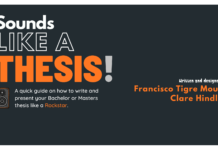Yippee you’ve done it. Just need to write the conclusion, won’t take 2 minutes, just repeat the preceding X number of pages in short form, try not to sound exactly like the data analysis and results, but hey this is easy….
Actually the conclusion shouldn’t be the most difficult thing to write, but it is mega important as that is the message you’re leaving your reader with. Imagine if the last pages of a novel simply summarise what went before. We need a climax, that has been built up throughout the thesis with a clear take home for the reader, a clearly stated conclusion. We don’t need a Star Wars ‘I am your father moment’ or any other major surprises, the conclusion should be logical, structured and expected (after your wonderful research and analysis).
A GOOD CONCLUSION IS……..
A brief summary of your findings including:
a. Your research question(s) – Have you answered/could you answer it/them completely?
[If your thesis looks at what the impact of Films on Tourists’ Destination Choices is, then have a look and consider how much you actually managed to answer this. Maybe you were restricted in the number of destinations you looked at, maybe you were restricted in the type of people you could survey (majority who answered were all 20-35/ majority who answered were male), maybe you couldn’t really ‘measure’ the impact, etc etc. Point all of this out.]
b. Your aims and objectives. – Have you/were you able to fulfill them all?
[Taking the film topic above, maybe in your aims and objectives you wanted to look at both positive and negative impacts e.g. James Bond car chase in beautiful Rome and the criminals in seedy, dark Mexican bars. However, none of the people answering your survey could recall ‘negative’ images and only reported ‘positive’ pictures. Therefore, you can’t really say much about negative images.]
c. Your expectations – Were they fulfilled? Partly, wholly, not at all?
[You established hypotheses:
H1 Films have an impact on tourists’ destination choices.
H2 Maintaining popularity is more difficult for destinations purely famous as a film location.
H1 was proven as 95% of the 250 people who answered your survey indicated that they would visit a location purely because it was a film location.
H2 Could not be proven as the respondents’ answers did not differ significantly for destinations only famous for films and those famous for film but also already established tourist destinations.]
d. Implications for industry – This basically means ‘who the hell cares?’ What use is your study for practitioners?
[The film study would be very useful for destination marketers. Although you could not show how long the appeal lasts, you have shown that a significant number of people consider film location a good reason to visit a destination.)
e. Implications for future research. – So this is how far you got, but what is the next stage? Where is more research needed? How can the gaps in your research be filled?
[Following on from d. you would advise that research is carried out on the appeal of film locations over time. Possibly also that a more representative sample is used to collect data i.e. broaden the age group, nationalities, gender etc.]
f. A final paragraph with a concluding statement.
NOTE: The conclusion can be as long as necessary – if the above is described in detail in our results section, then the conclusion will be correspondingly shorter.
Video Support: Conclusion
In case you are enjoying the article, do not forget to watch the video with further support on how to write the conclusions of your research.
A GOOD CONCLUSION ISN’T….
a. Someone else’s. Don’t conclude with citations and quotations. This is what you have to say.
b. A direct repetition of any other section of the thesis i.e. don’t just repeat the words of the results/data analysis section.
c. Cut and paste – i.e. don’t repeat any other part of the thesis word for word.
REMEMBER
You can’t write the Conclusion without close reference to the rest of your thesis. There MUST be a clear link to the statements made in the Introduction.
The Conclusion completes the loop.
SUMMARY
After reading this you should be able to:
1. Create a clear structure for your conclusion.
2. Create a clear link back to the introduction.
3. Show the significance of your findings for both industry and academia.
4. Complete the circle – Intro — Literature review – Methodology – Data Collection – Data Analyis – Limitations – Recommendations – Conclusion.
Once you’ve done, read it all through and pat yourself on the back!
What I do to switch off from screenwork: # READ TINTIN # PLAY CHOPIN





